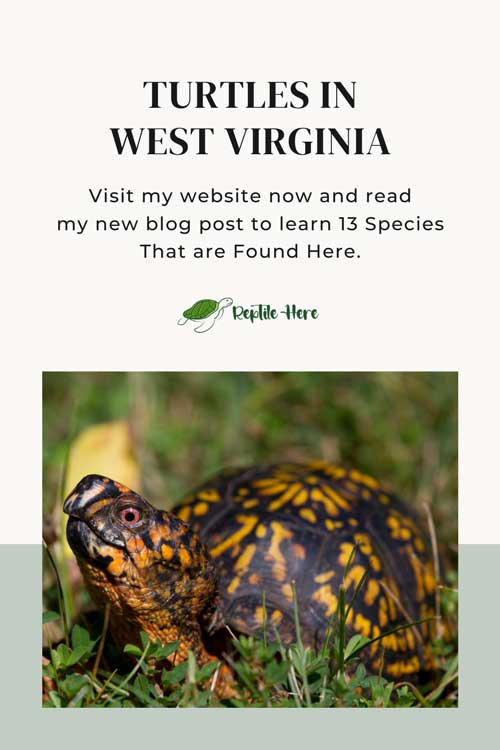Turtles in West Virginia – 13 Species That are Found Here
West Virginia is home to 13 species of turtles, with 10 of them being native to the region. The majority of these native species are aquatic and include northern map turtles, spiny softshells, Cooter turtles, and more.
Eastern box turtles are also native to the state and are the only terrestrial turtles found in West Virginia.
Red-eared sliders and common snapping turtles are some of the intruders that are non-native to the state.
In this article, we take you through the complete list of turtles in West Virginia. For each species, we have discussed key facts such as physical appearance, habitat, diet, size, lifespan, and more.
13 Types Of Turtles in West Virginia
Contents
1. Common Snapping Turtle
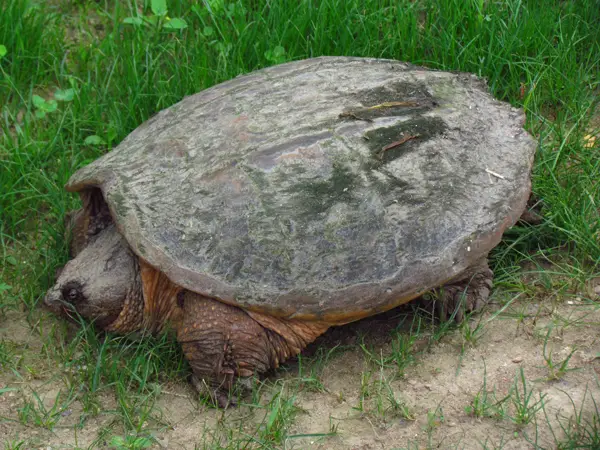
- Scientific name: Chelydra serpentina
- Common name: Snapping Turtle
- Family: Chelydridae
- Size: 8 to 18 1/2 inches
- Lifespan: 30 to 50 years or more
- Conservation status: Least Concern
Common snapping turtles are widespread throughout West Virginia. An average adult is pretty large and has a shell length of 18½ inches long. It is, no doubt, the biggest guy in West Virginia!
This species has a chunky head, a long tail, and large webbed feet. The shell color is black or olive and has no distinct pattern. These West Virginia snapping turtles are known for their powerful jaws—they’re so strong that these turtles eat other turtles!
You’ll find them in waterbodies with muddy bottoms. Examples include marshes, ponds, lakes, rivers, and even shallow streams. They generally prefer waters with aquatic vegetation in plenty and foods such as fish, frogs, birds, etc.
These West Virginia turtles generally show docile behavior but can get quite aggressive if taken out of water. The best way to calm it is to take it back to the waters, where it feels safe.
2. Eastern Spiny Softshell Turtle
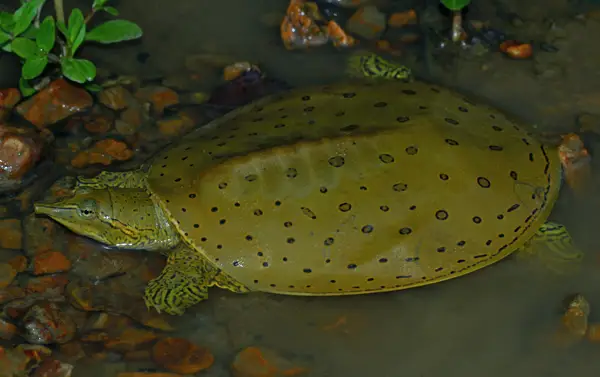
- Scientific name: Apalone spinifera
- Common name: Spiny Softshell Turtle
- Family: Trionychidae
- Size: 5 to 9 inches (males), 12 to 20 inches (females)
- Lifespan: 30 to 70 years
- Conservation status: Least Concern
The Eastern Spiny softshell turtle is a medium-to-large freshwater species that lives in West Virginia’s lakes, streams, and rivers with muddy or sandy bottoms and little or no vegetation.
Female spiny softshell turtles are usually larger than males. And unlike other turtles, this species has a flexible, leather-like carapace that’s extremely rounded and flattened. The shell color can be olive grey or yellow-brown. Just like other softshell turtles, this species also has a snorkel-like snout.
The young ones feature well-defined round spots that are easily visible on the shell (though these spots become invisible as they transition to adulthood).
Spiny softshell turtles in West Virginia tend to eat anything they find in the waters including crayfish, insects, small fish, and so on. They hunt by burying themselves in the mud or sand while keeping their head uncovered to grab food as it swims by.
These turtles are also able to breathe underwater by taking in oxygen through their throat skin. This is a useful adaptation given that they don’t spend a lot of time out of water.
Other adaptations of these turtles include webbed feed, long claws, and extremely flat shells that enable them to quickly swim away from predators and burry in the muddy bottom of the waters they reside in.
3. Midland Smooth Softshell Turtle
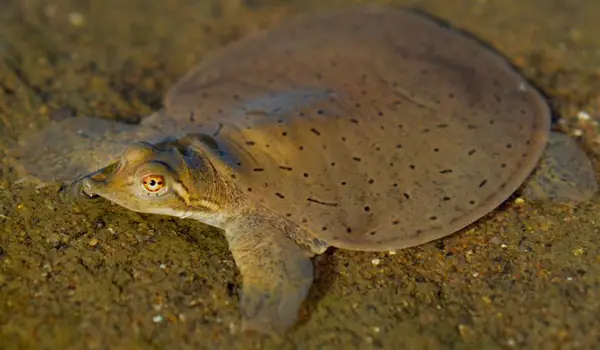
- Scientific name: Apalone mutica mutica
- Common name: Midland Smooth Shell
- Family: Trionychidae
- Size: 6 to 13 inches
- Lifespan: 40 to 60 years
- Conservation status: Least Concern
The smooth softshell turtle boasts its position as the fastest turtle on land in West Virginia!
Though most people believe these turtles are slow-moving, they must be quick to enable them to outrun their predators given that their soft shells don’t offer much protection.
The Shell color of this turtle species ranges from olive to dark brown. The upper part of its shell features dark markings (with female markings appearing in a blotchier pattern than the males’)
The shell of these turtles also appears rounder and flatter, just like other softshell species.
Note that Gulf Coast smooth turtle (Apalone calvata) is the closes relative of this Midland smooth softshell turtle.
These turtles like inhabiting waterbodies like rivers and streams in West Virginia that provide an abundance of mud or sand at the bottom. They can also be found in stagnant waterbodies.
Smooth softshell turtles of West Virginia are omnivorous and their diet revolves around aquatic vegetation and insects.
However, they have been observed to like meat more than plant matter and will mainly eat snails, insects, and fish.
4. Eastern Painted Turtle
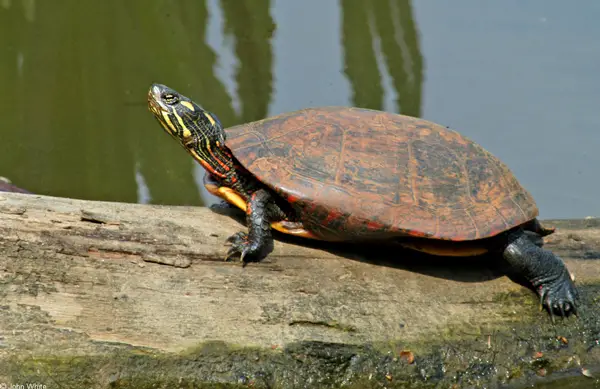
- Scientific name: Chrysemys picta
- Scientific name: Chrysemys picta picta
- Common name: Painted Turtle
- Family: Emydidae
- Size: 4 to 6 inches
- Lifespan: 30 to 50 years
- Conservation status: Least Concern
The Eastern painted turtle is one of the most recognizable turtle species in West Virginia, thanks to its beautiful and unique coloring.
The bright reds and yellow-green markings on its shell, head, and limbs are no doubt a beauty to behold!
This painted turtle sub-species in West Virginia has been observed to live near water bodies with minimal movements. Examples include marshes, ponds, slow-moving streams with sandy/muddy bottoms, small lakes, etc.
They also prefer areas with aquatic plants in plenty as they make their primary food source in the wild.
One interesting fact about these West Virginia turtles is their ability to hold their breath for up to 30 hours when inside temperate water. Moreover, they’re capable of standing dominant in freezing cold waters for up to 4 months.
Unfortunately, it’s not easy to establish the population of these turtles in West Virginia. This is because most people who pet them end up releasing them back into the wild.
This contributes to an ever-expanding range plus unstable reproduction rates for these turtles.
5. Northern Map Turtle

- Scientific name: Graptemys geographica
- Common name: Northern Map Turtle, Common Map Turtle
- Family: Emydidae
- Size: 3 to 10 inches
- Lifespan: 30 to 50 years
- Conservation status: Least Concern
The common map turtle has also been observed in West Virginia. To be more specie, this freshwater turtle resides in the rivers and lakes of West Virginia.
They prefer living in large waterbodies with debris. These offer the perfect spots for basking while the water bodies enable them to spend their hibernation periods in winter completely submerged.
Like other map turtles, this common map turtle gets its name from the map-like pattern on its shell. Its shell is typically darker and ranges from brown to black. The map pattern has a lighter coloration.
The common map turtle of West Virginia is mainly carnivorous and feeds on mollusks such as clams and snails. It will also eat crayfish and insects. And when animal matter gets scarce, it will feed on plant matter.
Note that it may be difficult to spot a common map turtle in the wild in West Virginia. Although active during the day, these turtles are quite timid and will quickly retreat to the waters at the slightest disturbance.
6. Ouachita Map Turtle
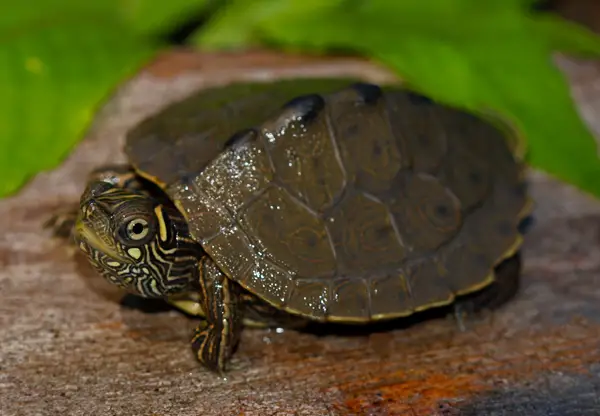
- Scientific name: Graptemys ouachitensis
- Common name: Ouachita Map Turtle, Map Turtle
- Family: Emydidae
- Size: 3 to 5 inches (males), 8 to 10 inches (females)
- Lifespan: 30 to 50 years
- Conservation status: Least Concern
The Ouachita map turtle lives in the northern part of West Virginia and is regarded as one of the less popular map turtle species. The turtle makes an excellent choice of pet for many people since it’s easy to care for.
As for its name, this species is named after the river where it was discovered—Ouachita!
Ouachita turtle is medium to large in terms of size. The average adult female is 3-5 inches long while the male is 8 to 10 inches long. It features thin, yellowing lines that form a web on the turtle’s shell (similar to a contour elevation map).
Moreover, the turtle has brown to olive coloring, with a light spot under both eyes.
The easiest way to identify this West Virginia turtle from other map turtle subspecies is by checking the dots on its face. They usually have 3 prominent spots—under the jawline, under the eye, and behind the eye.
Note that this turtle prefers living in stagnant or slow-moving waters, including ponds, lakes, and streams of West Virginia.
It also prefers waters with plenty of vegetation. This species is omnivorous and eats meat, insects, vegetables, fruits, and aquatic vegetation, to name but a few.
7. Eastern Musk Turtle
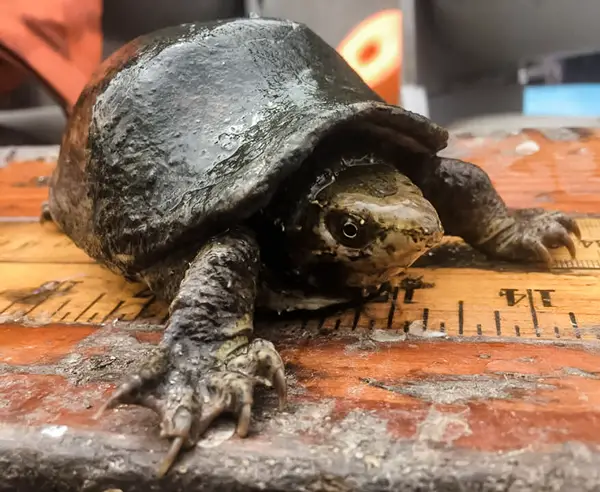
- Scientific name: Sternotherus odoratus
- Common name: Common Musk Turtle, Eastern Musk Turtle, Musk Turtle, Stinkpot
- Family: Kinosternidae
- Size: 2 to 4.5 inches
- Lifespan: 30 to 50 years
- Conservation status: Least Concern
The Eastern Musk Turtle is another aquatic turtle found in West Virginia’s slow-moving and sluggish streams as well as still water bodies.
The turtle usually prefers areas with dark crevices, where it can easily hide. It also prefers lots of plant matter to burrow in and hide.
An average adult eastern musk turtle is quite small (2 to 4.5 inches long). It has a pretty plain appearance with highly consistent colors. Both the shell and skin usually share the same color and can range from dark brown to black.
The turtle shell has one unique feature—a ridge traversing its entire shell length. Besides, it has another distinctive feature: two light-colored stripes on its head.
Eastern musk turtles of West Virginia are herbivorous and will eat small aquatic or semi-aquatic animals, carrion, and aquatic vegetation. They will also feed on any other vegetation on land.
When it feels threatened, this musk turtle species emits a foul odor (a musky odor, hence its name). This scent can be detected in water or on land. It can also easily waft through the air to its predators.
Also, these West Virginia turtles are good at climbing trees! This great capability enables them to go high up tree branches to find a safe resting place and avoid predators.
8. Eastern River Cooter
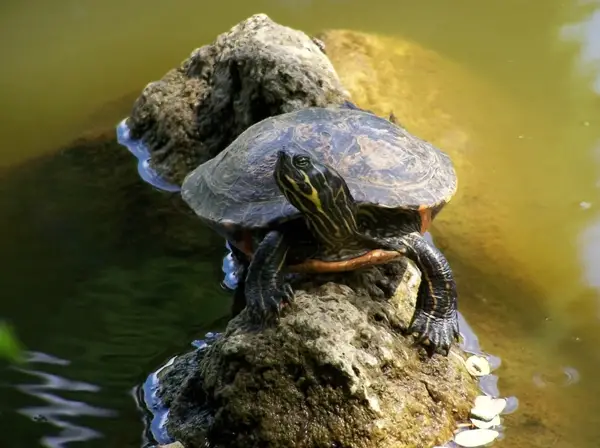
- Scientific name: Pseudemys concinna
- Common name: River Cooter
- Family: Emydidae
- Size: 8 to 12 inches
- Lifespan: 20 to 40 years
- Conservation status: Least Concern
River Cooter turtles are also inhabitants of eastern half area of West Virginia state. They’re known to be solitary creatures and often like basking alone in the sun. However, they can be sometimes observed sharing habitat with painted turtles and red-eared sliders.
They’re distinguishable by their brown to olive or dark-green outer shell and lighter c-shaped, concentric markings in their scutes. Their skin can be olive or olive-brown in color, with numerous yellow lines.
Most of these turtle adults are around 8 to 12 inches in size, though it’s not rare to come across females with a bigger size—up to 15 inches.
These turtles are pretty fast both on land and in water. They’re found in various freshwater bodies including lakes, ponds, and rivers in West Virginia. They’re also found in brackish water.
Their diet is primarily herbivorous and mainly consists of various forms of aquatic vegetation and land plant matter, including fruits and vegetables. They’re however known to occasionally feed on insects and snails.
9. Northern Red-bellied Cooter
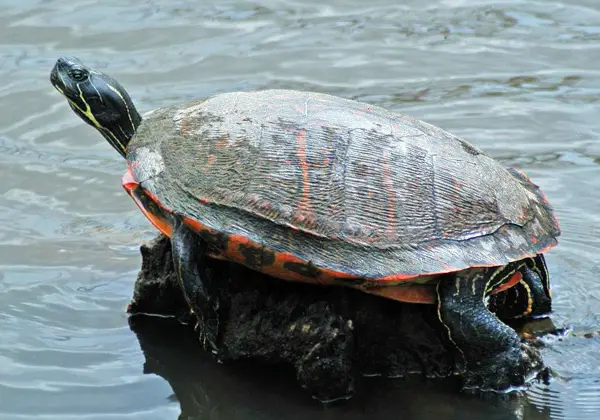
- Scientific name: Pseudemys rubriventris
- Common name: Northern Red-Bellied Turtle,American red-bellied turtle
- Family: Emydidae
- Size: 10 to 12 inches
- Lifespan: 40 to 60 years
- Conservation status: Not Threatened
As you can tell from its name, this species features a completely red (vibrant) plastron, sometimes covered with green spots. The turtle is known to live in freshwater streams, ponds, and lakes in West Virginia.
And when the conditions allow, the turtle will venture into brackish streams near the West Virginia coast.
A redbelly Cooter differs from other turtles with its head pattern which has lighter markings forming a distinct arrow shape, pointing toward the snout. The upper shell ranges form from dark brown to black.
Since the Northern redbelly turtles of West Virginia are mainly herbivorous, they mostly feed on aquatic plants.
Note that this turtle species in West Virginia face many threats including wetland loss, habitat loss, pollution, and collection for selling as pets.
At some point, this turtle was even sold for consumption (some countries still consume it even today!)
10. Red-eared Slider
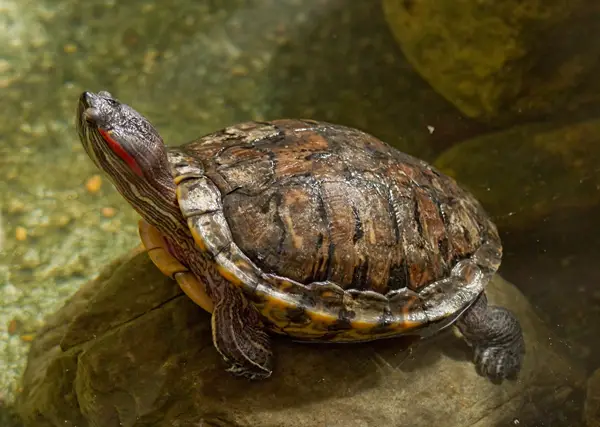
- Scientific name: Trachemys scripta
- Common name: Red-eared Slider, Red-eared Terrapin
- Family: Emydidae
- Size: 7 to 11 inches
- Lifespan: 30 to 40 years
- Conservation status: Least Concern
The red-eared slider is a sub-species of pond sliders and a non-native species of West Virginia. It is a semi-aquatic turtle and prefers living in marshes, ponds, lakes, and creeks.
A red-eared slider gets its name from the small red stripe surrounding its ears (or behind the eye), and its ability to quickly slide off logs and rocks into the water.
Generally, the skin and shell coloration of this slider can be brown or black, with yellow stripes covering the skin.
The red-eared sliders of West Virginia are pretty large and the adults reach 7-12 in length (though females are generally larger than males).
These West Virginia pond sliders are omnivorous and like eating fish, snails, insects, and aquatic vegetation. They also eat land vegetation, including fruits and vegetables.
11. Spotted Turtle
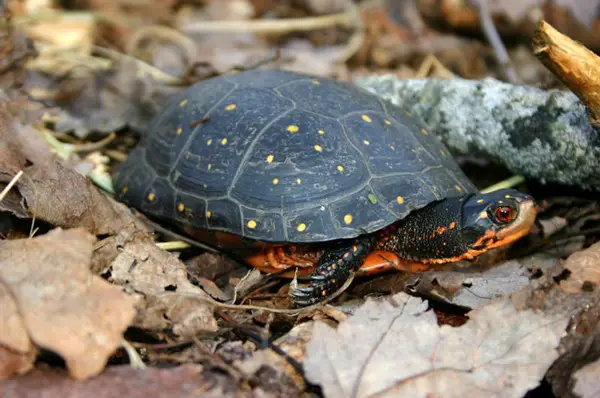
- Scientific name: Clemmys guttata
- Common name: Spotted Turtle
- Family: Emydidae
- Size: 4 to 5 inches
- Lifespan: 25 to 50 years
- Conservation status: Endangered
Spotted turtles in West Virginia reside in shallow marshes, swamps, and bogs. They’re semi-aquatic and are comfortable on the land just as they are in the waters.
An adult spotted turtle has a smooth upper shell that ranges from olive to dark brown in color, with some light yellow spots. The neck and head feature irregular orange or yellow spots and streaks. Also, their tails are fairly long.
The turtles are omnivorous and their diet involves crustaceans, mollusks, insects, and plant matter (occasionally). Note that these turtles are aggressive hunters and will actively seek their prey.
Unfortunately, the population of spotted turtles in West Virginia is on the decline due to human interference and habitat loss. Their unique shell patterns make them a favorite species of a pet turtle for many people.
For this reason, they’re listed as endangered and protected by many governing bodies. In West Virginia state, you can only own ONE spotted turtle and not more than that!
Above all, the spotted turtles of West Virginia are incredibly smart. Studies carried on them using a maze indicate they have the same brain capacity as the mouse!
12. Wood Turtle
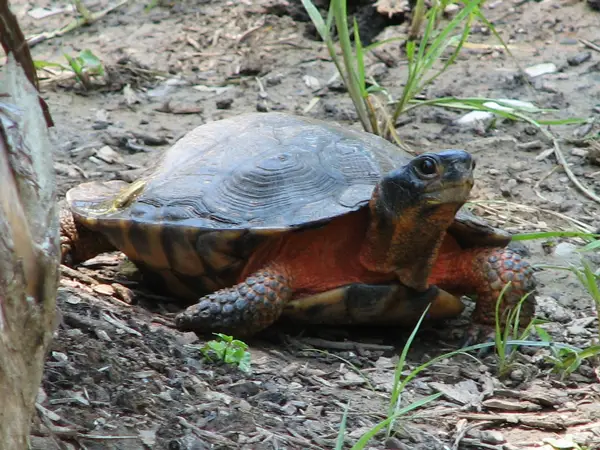
- Scientific name: Glyptemys insculpta
- Common name: Wood turtle, Sculptured Tortoise, Redleg, Red-legged Tortoise
- Family: Emydidae
- Size: 5.5 to 8 inches
- Lifespan: 40 to 60 years
- Conservation status: Endangered
Wood turtle species also inhabit the various woodland habitats across West Virginia state. However, they also tend to stay near the water and will frequently venture into it.
During winter, they tend to hibernate at the bottom of deep rivers and pools.
The turtles get their name from their sculpted-like looks. Their upper shells are dark brown and have sport patterns resembling wood grain and growth rings.
Their scutes may sometimes appear like they’re pyramiding, further enhancing their sculpted shape.
Wood turtles of West Virginia are diurnal omnivores and their diet mainly consists of berries, plants, insects, and mollusks.
They forage for their food widely and have even been observed stomping their feet on the ground as a way of tricking the earthworms into surfacing.
13. Eastern Box Turtle
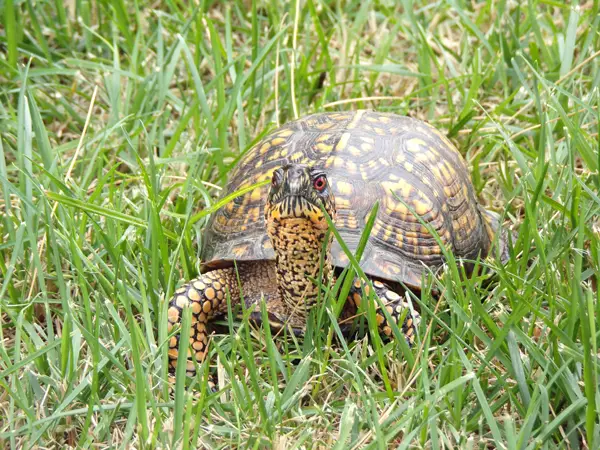
- Scientific name: Terrapene carolina
- Common name: Eastern Box Turtle, Land turtle, Box Turtle
- Family: Emydidae
- Size: 4.5 and 7 inches
- Lifespan: 50 to 100 years
- Conservation status: Vulnerable
The eastern box turtles are native to West Virginia. They prefer these areas due to abundant access to sunlight and food sources nearby.
An adult turtle of this species is about 4.5 to 7 inches and weighs just 2lbs. It has a high, domed shell shape with a ridge running from head to toe. The shell of this turtle has varying colors of olive, brown, and tan.
The variation in markings on the shells of these turtles is so variable that you can’t easily recognize one by looking at the shell alone.
These eastern box turtles of West Virginia are omnivorous and feed on a variety of foods including insects, meat, fruits, vegetables, and various types of vegetation.
Note that eastern box turtles are taken from the West Virginia wild for pet trade, leading to a decline in their population. For this reason, many states have illegalized capturing and selling of this species.
And those in captivity end up dying due to poor conditions or being abandoned or released back into the wild because they’re too demanding to maintain.
Conclusion
Now you know what turtles live in West Virginia and the basic information about each of them including what they eat, where they live, their physical appearance, and how long they live.
Only 10 turtles featured on this list are truly native to the state and all of them are freshwater species. The eastern box turtle is the only terrestrial turtle native to West Virginia.
Invasive turtles of West Virginia include the painted turtles, common snapping turtles, and red-eared sliders.
Collection of protected species such as the eastern box turtles is prohibited in West Virginia to help preserve their delinking population.
